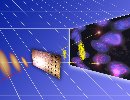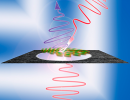Applications
The claim that laser-driven ion beams bare high potential for applications, eventually even for a cost-effective therapy, is commonly based on the fact that the field structures in which the ions are accelerated have considerably smaller dimensions as compared to conventional accelerators. This may promise more compact and therefore less expensive accelerators in the future.
But the microscopic dimensions over which electrons and ions are rapidly accelerated by the gigantic fields that are set up by the laser offer even more. A typical PW-class laser pulse can, for example, accelerate ions from a micrometre small source to 10-30% of the speed of light within less than 100 femtoseconds. It is this accurate definition in space and time, typically referred to as (ultra)small emittance, which can enable experiments with sub-ps temporal and micrometer spatial resolution.
More strikingly, ion bunches can be accelerated by the same laser pulses as electron bunches, simply by adjusting focusing and target conditions. This synchronism can be exploited further, ions can be converted into neutrons, relativistic electron pulses are excellent sources of X-UV, X-ray or even Gamma-ray bursts, all with durations of a few femtoseconds or even sub-fs, and all synchronised to within the same time scales. This quality is indeed unique and eventually not even achievable by means other than high power lasers. We aim to develop methodologies to a maturity that allows harvesting those opportunities and demonstrating first applications with pulsed, laser-driven ion sources.



